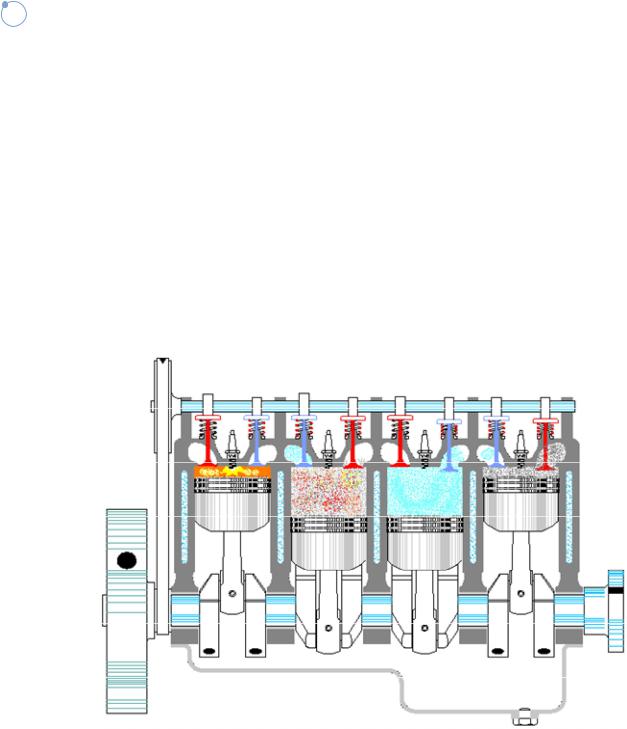
- •PART ONE
- •I. THE HISTORY OF THE CAR
- •Текст 1
- •Текст 2
- •Текст 3
- •TEST YOURSELF
- •II. AUTOMOBILE
- •Текст 1
- •Текст 2
- •Текст 3
- •Текст 4
- •Текст 5
- •Текст 6
- •Текст 7
- •Текст 8
- •Текст 9
- •Текст 10
- •Текст 11
- •Текст 12
- •Текст 13
- •Текст 14
- •Текст 15
- •Текст 16
- •Текст 19
- •Текст 20
- •Текст 21
- •Текст 22
- •Текст 23
- •Текст 24
- •Текст 25
- •Текст 26
- •Текст 27
- •Текст 28
- •Текст 29
- •Текст 30
- •Текст 31
- •Текст 33
- •TEST YOURSELF
- •PART TWO
- •CLASSIC CARS
- •Текст 2
- •Текст 6
- •Текст 8
- •Текст 17
- •Текст 21
- •Текст 24
- •Текст 25
- •TEST YOURSELF
- •VOCABULARY
- •БИБЛИОГРАФИЧЕСКИЙ СПИСОК

Министерство науки и высшего образования РФ Федеральное государственное бюджетное образовательное учреждение
высшего образования «Сибирский государственный автомобильно-дорожный университет (СибАДИ)»
М.В. Цыгулева, А.В. Кузюкова, Л.Ф. Герасимова
АВТОМОБИЛЬ
AUTOMOBILE
Учебное пособие по дисциплине «Иностранный язык»
2-е изд., деривативное
Омск – 2018

УДК 42:629.114 |
Согласно 436-ФЗ от 29.12.2010 «О защите детей |
ББК 81.432.1:39.3 |
от информации, причиняющей вред их здоровью и |
Ц94 |
развитию» данная продукция маркировке не |
|
подлежит. |
|
Рецензенты: |
канд. филол. наук, доц. М.А. Федорова (ОмГТУ); канд. филол. наук, доц. Т.А. Винникова (ОмГТУ)
СибАДИПредназначено для бакалавров и магистров, получающих образование по направлениям подготовки «Наземные транспортно-технологические комплексы», «Эксплуатация транспортно-технологических машин комплексов», «Технология транспортных процессов» для всех форм обучения.
Работа утверждена редакционно-издательским советом СибАДИ в качестве
учебного пособ я.
Цыгулева, Маргарита Викторовна.
Ц94 Автомоб ль = Automobile [Электронный ресурс]: учебное пособие по
дисц пл не «Иностранный язык» / М.В. Цыгулева, А.В. Кузюкова, Л.Ф.
Герас мова. – Электрон. дан. – Омск : СибАДИ, 2018. – URL: http://bek.sibadi.org/ cgi-bin/irbis64r plus/cgiirbis 64 ft.exe. - Режим доступа: для авторизованных пользователей.
ISBN 978-5-00113-096-3.
Цель посо |
я – развитие иноязычной коммуникативной компетенции у |
студентов бакалавр |
ата магистратуры технического вуза. |
Изложен материал, позволяющий будущим инженерам осваивать |
|
профессиональную терминологию, развивать навыки чтения, аудирования, устной |
|
и письменной профессионально ориентированной речи. |
|
Имеет интерактивное оглавление в виде закладок. Содержит |
|
видеофрагменты |
о учающего и демонстрационного характера, которые |
воспроизводятся с помощью проигрывателя Windows Media. |
|
Подготовлено на кафедре «Иностранные языки».
Мультимедийное издание (10 МБ)
Системные требования : Intel, 3,4 GHz ; 150 МБ ; Windows XP/Vista/7 ; DVD-ROM ; 1 ГБ свободного места на жестком диске ;
программа для чтения pdf-файлов :
Adobe Acrobat Reader; Google Chrome ; Windows Media Player ; колонки
Редактор Н.В. Павлова Техническая подготовка Н.В. Кенжалинова
Издание второе, деривативное. Дата подписания к использованию 12.11.2018 Издательско-полиграфический комплекс СибАДИ. 644080, г. Омск, пр. Мира, 5 РИО ИПК СибАДИ. 644080, г. Омск, ул. 2-я Поселковая, 1
© ФГБОУ ВО «СибАДИ», 2018

Ссылки на видео внутри работы кликабельны
PART ONE
I. THE HISTORY OF THE CAR
3
There were many inventions during the Twentieth Century – the telephone,
СибАДИIII. Assessment criteria should be developed and discussed beforehand. Remember that different aspects should be taken into account (such as correctness, richness of content, design, etc.).
air travel, television and the atomic bomb – are just four with universal impact. But one stands out from the crowd as having had more influence on more people in more places – the CAR.
Задан е 1. Как е факты из истории атомобиля Вам известы? Обсудите х в парах/тройках, отвечая на вопросы друг друга (What? Where? Who? When? Why?).
Задан е 2. Используя нформацию из текстов, приведенных в этой части (I. THE HISTORY OF THE CAR), подготовьте презентацию и представьте её группе. Будьте готовы задавать вопросы выступающим. Выбер те самый лучший вариант объясните, почему Вы так считаете.
Обратите внимание:
I. The PowerPoint presentation should be not less than 10 slides. The
first slide is the title (the name of your project, your education institution, your name and surname, your group and specialty). The last slide should include the references.
|
II. Ordinarily presentations have three main parts: |
- |
introduction |
- |
main part |
- |
conclusion. |
IV. Useful words for your presentation:
to clarify, to focus on, to highlight, to illustrate, to indicate, to lead to, to mention, to move on to, to note, to notice, to pass on, to rise, to solve, to summarize, to update
V. Making a presentation you should use phrases given below and follow the plan.
3

1. Welcome the audience:
Good morning / afternoon. Hello / Hi, everyone.
2. Introduce yourself:
Let me introduce myself. / I’m …., the first/second/…-year student of the Siberian State Automobile and Highway University. I study at the Auto-
Сmobile Transport Faculty.
4
3. Say what the topic is:
As you can see on the screen, our topic today is … / Today’s topic is … / The subject of my presentation is …
5.иSay about timing:
4. Explain why audience will be interested:
My talk is particularly relevant to those of you who … / Today’s topic is of particular interest to those of you who …
My presentationбАwill take about 7 minutes.
6. Handouts:
Don’t worry about taking notes. I’ve put all the important statistics on a handout for you. / I’ll email the PowerPoint presentation to you.
7. Questions:
There will be time for questions after my presentation.
8. Start your report:
So, let me first give you a brief overview. / In this part of my presentation, I’d like to talk about …
9. Indicating the end of a section:
This brings me to the end of my first point. / That’s all I wanted to say about …
10. |
Summarizing a point: |
|
|
Let me briefly summarize the main issues. / I’d like to summarize what |
|||
I’ve said so far. |
И |
||
Д |
|||
11. |
Moving to the next point: |
||
This brings us to the next question. / Let’s now move on … / Let’s now take a look at …
12. Going back:
As I said … / As I mentioned earlier … / Let me come back to what I said before …
13. Adding ideas:
In addition to this, … / Moreover, there are other interesting facts we should take a look at.
4

14. Signal the end of your talk:
Well, this brings me to the end of my presentation. / Finally, I’d like to highlight one key issue.
15. Summarize the key points.
Before I stop, let me go over the key issues again. / In conclusion, I’d like
Сto … / To sum up, we …
5
16. Make your final statement:
I would like to finish my talk with an important question. / Let me go back to …
17. Thank the audience:
Thank you very much for your attention. / Thank you for listening.
иТекст 1
The significanceбАof the motor car to the recent history of civilization is beyond question. The car’s precise date of introduction, however, will be debated for decades to come. That’s because, ever since the invention of the wheel around 4000 BC, humans have tried to design a self-propelled machine to replace the horse.
Karl Benz and Gottlieb Daimler may have been credited with producing the first vehicles powered by the internal combustion engine in 1885, but the origins of the car go back as far as the Old Testament. This foretold of machines propelling themselves on land and the air. The great 13-th-century
scientist and philosopher Roger BaconДpredicted the advent of machinepowered vehicles on land and water, while Leonardo de Vinci’s diagrams of a self-propelled carriage are a matter of record. In 1472, Roberto Valturio described a machine (fig. 1) designed for war purposes, which was to be moved by means of large windmills transmitting their motion through cranks and gears. Clockwork and wind-assisted vehicles all playedИtheir part in the prehistory of the car but the greatest influence came from the Steam Age. In the early 1760s Frenchman Captain Nicolas Joseph Cugnot built a powerful steam-driven tractor to tow artillery hardware. Only partly successful, it was left to a group of British, American and European inventors to pursue the development further. Of these, Richard Trevithick’s London Carriage was both the most practical and effective.
The steam era saw not only the advent of a succession of road coaches but also the more recent railway locomotive. The former was handicapped by public resistance and government legislation, while those involved in the horse trade saw these new contraptions as a danger to their livelihood. This led not only to heavy taxation through toll roads but also
5

the implementation of the Red Flag Act. This ruled that all forms of ‘road locomotives’ should have a man with a red flag walking ahead of them. This ridiculous law was not repealed until many years later.
С6 и
бАFig. 1. Wind-driven vehicle by Robert Valturio
Текст 2
THE POWERДSTRUGGLE
It was the development of the internal combustion engine from the mid-1800s onwards which spurred inventors on to develop ‘horseless carriages’. Nikolaus Otto is generally regarded as being the father of today’s petrol engine but its origins date back much further. The initial idea can be traced to the 1670s, from when there survive theИfirst descriptions of a piston sliding within the cylinder, powered by gun powder – in effect, a development of the cannon. This was put into practice by a number of engineers, one of whom was the Swiss, Francois Issac de Rivaz, who even used electricity to supply the ignition.
Arguments still rage today among automotive historians concerning the identity of the individual who created the first ‘true’ internal combustion engine. Etienne Lenior won the race to patent his design first in 1859, but the Italians Barsanti and Matteucci had working designs on display several years earlier. Lenior’s patent was more in line with the modern engine as we know it however, and was a spur to future innovators like Nickolaus Otto, Gottlieb Daimler and Karl Benz. Otto’s four-stroke engine
6

(the four ‘strokes’ of the cycle being: Induction, Compression, Ignition, Exhaust) was a refinement of Lenior’s idea, and provided the motive power for the motor car in more ways than one (fig. 2).
Otto had a though time realizing his vision. Having learned of Lenior’s gas engine, and being further inspired by seeing the Barsanti and
СMatteucci idea on a trip to England, he developed a similar unit designed
7
to run on liquid fuel. However, as the history of the automobile constantly shows, some of the greatest innovators had poor business minds. Otto needed future car enthusiast Eugen Langen to both help secure a patent and alsoиsee the venture through bleak times when technical problems halted sales for a while.
It is unfair to credit any one person with the creation of the car. Gottlieb Daimler, who worked with Otto until their differing views caused a fall-out, developedбАhis own engines. These were not solely for car use, but he did build the first four-wheel horseless carriage. Karl Benz, who lived less than 100 miles away, designed his advanced tricycle which proved to the first truly purpose-built machine. Amazingly, not only did the pair never meet, but were even unaware of each other s efforts as they worked on parallel designs.
By 1886 the motor car was definitely ready to roll.
Д И
Fig. 2. Otto’s internal combustion four-stroke cycle
7
